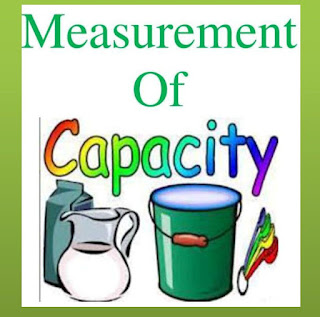LESSON PLAN OF MEASUREMENT OF CAPACITY
LESSON PLANNING OF MEASUREMENT OF CAPACITY
Subject Mathematics
Grade 2nd
Students` Learning Outcomes
- Recognize the standard units of mass / weight, i.e. kilogram, gram.
- Read and write standard units of capacity / volume including abbreviations.
- Solve real life problems involving capacity / volume.
Information for Teachers
- The things which flow are called liquid.
The quantity of liquid which is required to fill a container is called capacity of that container.
- The quantity of liquid like milk, oil, petrol etc. is measured in liters.
- They are sold and purchased at rate of their per liter price.
- To measure liquids there are specific instruments having liter marks on them or specific containers representing different quantities of liter like one liter, five liter etc.
- While teaching the lesson, the teacher should also consult textbook at all the steps where and when applicable.
Material / Resources
Writing board, chalk / marker, duster, empty
bottles and packets of different capacities, measuring jug/beaker, tub, pale,
textbook
Introduction
- As the following questions to the students;
- Name different eatable items which are in liquid form?
- How liquid things are measured?
- What is the basic unit for measuring liquid?
- What is meant by the capacity of a container?
- How you will determine that the capacity of tub is more or pale?
- Which unit is used to measure ice-cream?
- Which unit is used to sell the petrol / diesel, cooking oil, milk and soft drinks?
Development
Activity 1
- Provide empty soft drink bottles, packets etc. having different capacity / volume to students.
- As them to read capacity / volume of each bottle and packet and tell the unit written with it.
- After taking their responses, tell them that the quantity of liquid which fill the container is called capacity of that container.
- We measure the quantity of liquid things in liter.
- Liter is the basic unit of capacity / volume.
- The abbreviation or symbol used for liter is.
- If quantity of any liquid is five liter then we write it as ‘5L’ and read as ‘5 liters’.
- Now ask the students to write capacity / volume of these things in their note books.
Activity 2
- Tell students any supposed stories about capacity / volume from daily life like yesterday, I went for shopping, in the way, I filled 2 liter of petrol in my car but it ends, therefore in return I filled 1 liter of petrol more.
- Ask students how many liters of petrol were filled in the car?
- From there I bought 5 litters sugarcane juice for family, 3 liter juice were used.
- Ask students how much juice was left over?
Activity 3
- Take two beakers and pour three liter water in each.
- Ask students to read quantity of water in both beakers.
- Write students answer on board.
- Tell the students, now we are going to find the total amount of water by collecting both beakers water in one beaker.
- Now students read the total amount of water from beaker and tell.
- Add these quantities on board and hence verify the answer.
- Now repeat these steps for subtraction process, for this take away few liter of water from beaker and pour it into other beaker and ask about the remaining quantity of water from students.
Activity 4
- Divide the students in groups.
- Write few word problems on paper chits.
- Ask each group to solve these questions and if possible play a role according to questions.
Sum up / Conclusion
- The things which flow are called liquid.
- The quantity of liquid which is required to fill a container is called capacity of that container.
- The quantity of liquid like milk, oil, petrol etc. is measured in liters.
- They are sold and purchased at rate of their per liter price.
- To measure liquids there are specific instruments having liter marks on them or specific containers representing different quantities of liter like one liter, five liter etc.
- The abbreviation or symbol used for liter is ‘L’ e.g. if quantity of any liquid is nineteen liters then we write it as ‘19l’ and read as ’19 liters’.
- Solve one or two word problems on the board.
Assessment
- How the cooking oil is measured?
- ‘l’ is the abbreviation of water?
- Speak quantities of few things in liter like twenty four liter oil, fifteen liter juice, two liter bottle etc. and ask students to write these quantities in their note books with abbreviation of liter and show.
- Write few word problems on board and let the students solve it.
- Ask students what they have learnt today?
Follow up
- Ask students to read measurement of different liquids and write them on note books with abbreviation. For example measurement of milk from milk packs the measurement of liquid things measured by shopkeeper etc.














Comments
Post a Comment